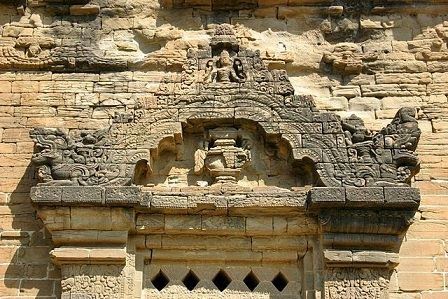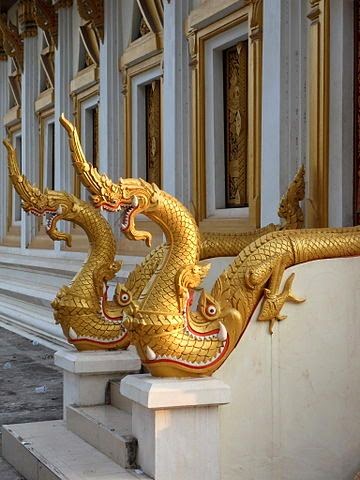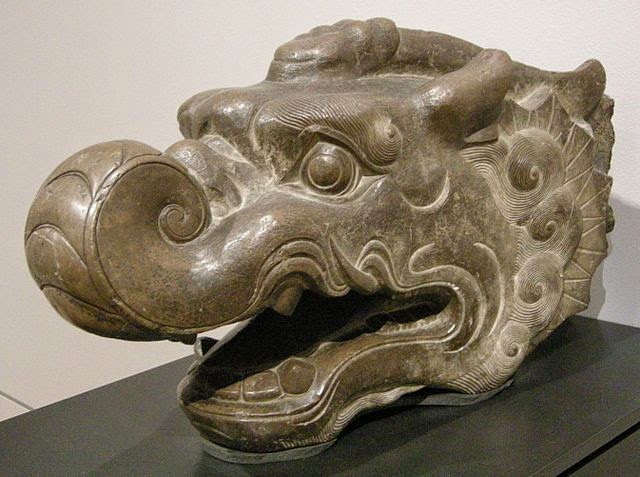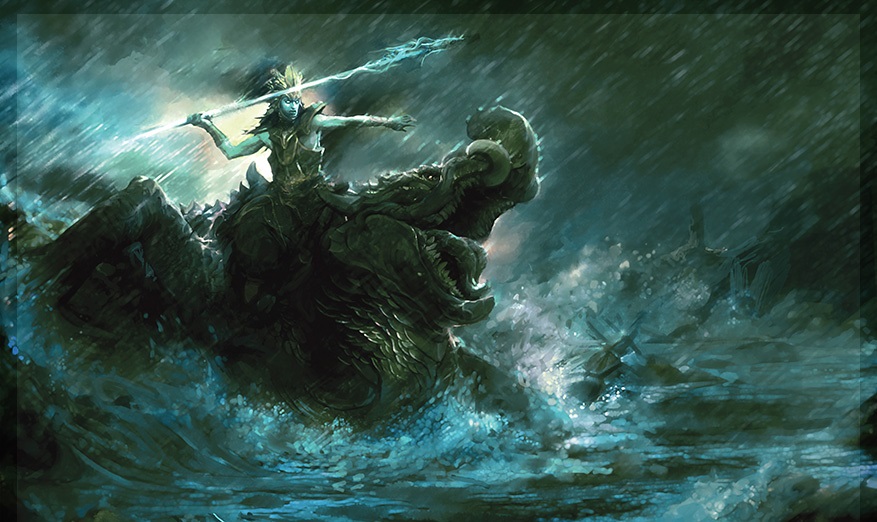You wouldn’t find any information on dinosaurs or other similar species in any of the ancient western texts but if you go through the ancient Indian literary texts, you might be able to extract some information on dinosaurs and other species similar to dinosaurs.
In Sanskrit Makara is a word that means sea dragon or aquatic monster, long thought to be a mythical creature in Hindu and Buddhist traditions. Paintings and sculptures of this fantastical creature are found in India, Nepal, Sri Lanka, Burma, Thailand, Cambodia, Malaysia, Indonesia, Vietnam, China and Japan. Description of Makara closely resembles dinosaurs. Makara is depicted as the half aquatic and half animal aggressive monster having head of a crocodile, horns of a goat, the body of an antelope and a snake, the tail of a fish or peacock and the feet of a panther.

In scriptures, the Makara is known to be the Vahana (vehicle) of the Ganga Devi (goddess of the river Ganges) . Makara is also described as the vehicle of Deity Varuna (the sea god). A Makara is also the insignia of Kamadeva (god of lust) and Kamadeva’s flag is called makara-dhvaja, a flag having the Makara drawn on it. Varuna is said to be the only one who can control the Makara and does not fear them. In Hindu astrology the Makara is also the astrological sign of Capricorn. A little research reveals this strange mythical creature to have been very popular both in ancient times and in our present day.
In some English translations of the Bhagwad Gita, for simplicity of reading, ‘makara’ has been translated as shark. But it is not a shark. Mahabharata mentions the Timingila and Makara as being deep within the ocean, along with other huge sea creatures:
Verse 168.3, Vana Parva, Mahabharata
timingilah kacchapasca tatha timi timingilah
makarascatra drsyante jale magna ivadrayah
Translation:
There were seen Timingilas, tortoises, Timi-timingilas and Makaras, that were like great rocks submerged in the water.
Also, some other text like Susruta Samhita, Bhagwad Gita and Bhagavad Purana depicts Makara and Timingila as the most dreadful amphibian species.
Chapter 45, Susruta Samhita
timi-timingila-kulisa-pakamatsya-nirularu
nandi-varalaka-makara-gargaraka-candraka
mahamina-rajiva prabhrtya samudrah
Translation:
The Timi, Timingila, Kulisa, Paka-matsya, Nirularu, Nandi-Varalaka, Makara, Gargaraka, Candraka, Maha-mina, and Rajiva etc, constitute the family of marine fish.
In Bhagavad Gita, Lord Krishna used Makara to represent entire aquatic species thus referring makara as the king of all aquatic species.
Verse 31, Chapter 10, Bhagavad-gita
pavanah pavatam asmi ramah sastra-bhrtam aham
jhasanam makaras casmi srotasam asmi jahnavi
Translation:
Of purifiers I am the wind. Of the wielders of weapons I am Rama. Amongst aquatics I am the makara and of rivers I am the Ganga.
In Srimad Bhagavatam, Makaras and Timingila are explicitly stated as dangerous predators that attacked sage Markandeya
ksut-trt-parito makarais timingilair upadruto vici-nabhasvatahatah tamasy apare patito bhraman diso na veda kham gam ca parisramesitah
Translation:
Suffering from hunger and thirst, attacked by Makaras and Timingila and battered by the waves and the wind, Markandeya wandered through the infinite gloom that enveloped him. Overcome by exhaustion, he lost all sense of direction and could not ascertain what the sky was and what the earth was.”

Now your mind may be wobbling up with many questions like “Makara and timinglas are fine but if Indian ancient scriptures really have description about dinosaurs, then why not the details of other huge creatures that roamed on earth”.
Well, the answer to this specific question is that Ancient scriptures do refer to many other mammoth creatures. However the information is limited since such texts were composed for spiritual reasons and not as entertaining books/stories on dinosaurs. You may be aware that Indian scriptures are full of stories on fights between Gods and Demons. In such battles, both demons and gods are shown as seated on their specific vehicle, mostly a deadly predator. One of the verses that state the use of strange creatures in battles is as follows:
Chapter 8, Verse 10-12, Bhagavad Purana
grdhraih kankair bakair anye syena-bhasais timingilaih
sarabhair mahisaih khadgair go-vrsair gavayarunaih
sivabhir akhubhih kecit krkalasaih sasair naraih
bastair eke krsna-sarair hamsair anye ca sukaraih
anye jala-sthala-khagaih sattvair vikrta-vigrahaih
senayor ubhayo rajan vivisus te ’grato ’gratah
Translation:
O King, some soldiers fought on the backs of vultures, eagles, ducks, hawks and bhasa birds. Some fought on the backs of timingilas, which can devour huge whales, some on the backs of sarabhas, and some on buffalo, rhinoceroses, cows, bulls, gavaya [jungle cows] and arunas. Others fought on the backs of jackals, rats, krkalasa, rabbits, human beings, goats, black deer, swans and boars. In this way, mounted on animals of the water, land and sky, including animals with deformed bodies [vikrta-vigraha], both armies faced each other and went forward.

Some of the creatures in the above verse are not identifiable. Nobody knows the English or Hindi equivalent of animals like ‘bhasa’, ‘krkalasa’, ‘gavaya’, ’sarabhas’, ‘arunas’, and ‘vikrta-vigraha’. All of them are said to be aggressive predators. These may be the names of extinct species of dinosaurs or some other extinct species. Recent study of dinosaur dung and fossil fuel in central India (especially Pisdura village of Nagpur district) by scientists from US, china and India has concluded that “Few species of Dinosaurs in India fed on rice and a variety of rice was grown in India millions of years ago during the Cretaceous and Eocene period”, thus pushing back the date of Indian civilization to at least 65 million years old, the time when the landmass of Indian subcontinent was situated very close to continental shelf of Africa.
Recently, when huge dinosaur’s eggs were excavated in Gujarat, villagers thought those to be the boon of Lord Shiva and started worshipping such fossilized eggs as shiv-Lingam.
Central India is known as the largest dinosaur breeding site in the world from where the largest number of eggs and nest from a single period of time (68 to 65 million years ago) were excavated.
When it is obvious that scientists are not running around falsifying dinosaur fossils and that dinosaurs did indeed exist in India, then it is reasonable to conclude that dinosaurs are indeed mentioned in Vedic literature and that archaeologists may have recently found the Makara in the fossil record in England.
The fossilized Pliosaur was found in Dorset, England in 2003 and took until 2008 to remove from the rock cliff in which it was found. Once excavated it revealed a sea monster in remarkable detail.
Scientists suspect the Pliosaur fossil is approximately 155-million-years old and lived during the Jurassic and Cretaceous Periods during which time it was one of the top predators of the oceans.Paleontologist Richard Forrest commented to the BBC as follows:
“This is an iconic specimen – one of the most exciting we have seen in years. It was probably the most fearsome predator that ever lived.”
Dr. Forrest went on to say that the creature’s bulky body, which would have been powered through the water with four paddle-like limbs, has never been found and may not have fossilized. Scientist’s estimate based on the 2.4meter long skull, that the Pliosaur would have been 15 to 18 meters in length. We are herein suggesting that the Pliosaur could easily be the Makara of myth, but we are not the first to equate a mysterious ocean monster to the Makara. We have also stumbled upon the reports of a creature called the Ambulocetus, a creature that could walk as well as swim. It lived during the early Eocene Period some 50 million years ago. The fossil of Ambulocetus was found on the coast of Pakistan from a time when Pakistan and India was a single island in the Indian Ocean slowly drifting toward the continental shelf of Asia. Some crypto-zoologists speculate that the Ambulocetus is a candidate for being the Makara, yet most scientists suggest that the Ambulocetus fills the evolutionary gap between aquatics and land animals.
From the above verses, description of dinosaurs and other similar species is quite evident in ancient Indian literary texts.

According to Bhagavad Purana, combination of Yugas called as ‘Manvantaras’ repeat indefinitely where each Manvantaras is characterized by its own set of plants and animals. In Total, Vedas states 84,00,000 different species of animals. Some of the animals and plants of previous Manvantaras become extinct in next Manvantaras and then are revived again after series of Manvantaras. Additionally, Bhagavad Purana states that extinct species of previous Manvantaras are replaced by new species in next Manvantaras and this process of replacement is known as ‘Transmigration of souls’. Vedic theory states that Fish or any other aquatic animal, when brought on earth develops intense desires to breathe like an amphibian. As a result, they are born as amphibian in their next birth. With desires of becoming dangerous predators, they become lizards or snakes in their next life. Tired of slow motion, they develop a desire of running thus transmigrating into monstrous predators like dinosaurs in their next life. After series of births in desirable forms, they become extinct and the cycle starts from first phase again.Bhagavatam, Ramayana and Mahabharata all mention the existence of the Makara/Pliosaur and the Timingila/Megalodon, but where did the authors get their information?
When (by scientific estimation) human beings have only been on this planet since 1,250,000 years after the Megalodon/Timingila became extinct — who told the Vedic authors about these creatures? Scientists and scholars will have to ponder this question, but for us it is simple — there have always been human beings on this planet from its earliest beginnings and the knowledge of all such things has been passed down thru the ages via the disciplic succession of gurus and disciples.
Source: Gosai.com






For more fascinating facts regarding the extreme antiquity of Modern Man, you may read the exceptional, landmark work of Michael CREMO and Richard THOMSON: FORBIDDEN ARCHEOLOGY. The evidence cited in that work are amazing and overwhelming!!…
Marc de Logères